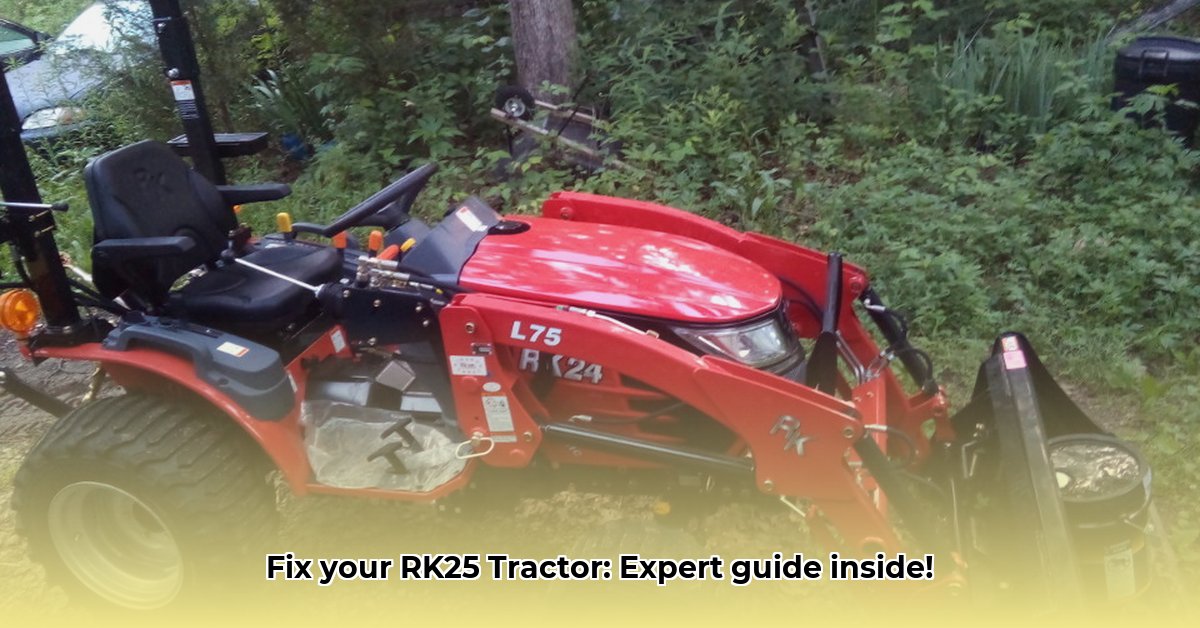
RK25 Tractor Problems: A Comprehensive Troubleshooting Guide
Owning an RK25 tractor, while offering a budget-friendly entry point to land management, can present unique challenges. Many owners report recurring issues, primarily affecting the engine, transmission, and hydraulic systems. This guide provides practical solutions for troubleshooting and maintenance, empowering you to keep your RK25 running smoothly and efficiently. We'll explore common problems, preventative maintenance strategies, and compare the RK25's reliability to similar Rural King models. For more tractor attachment information, check out these helpful resources.
Transmission Troubles: A Frequent Concern
The transmission system is a common source of frustration for RK25 owners. Overheating, often leading to costly repairs, is a frequent complaint. Several factors contribute to this, including prolonged operation under heavy loads, insufficient lubrication, and neglecting routine maintenance. Regular fluid checks and timely filter changes are crucial preventative measures. Failing to attend to these simple tasks can lead to significant problems down the line.
Step-by-Step Transmission Maintenance:
- Fluid Level Check: Regularly verify transmission fluid levels via the dipstick. Low levels directly contribute to overheating and internal damage.
- Fluid and Filter Replacement: Replace the transmission fluid and filter according to the manufacturer's recommended schedule. This proactive maintenance is essential for preventing premature wear.
- Workload Management: Avoid extended periods of heavy use. Allow the tractor to cool down between tasks to prevent overheating and stress on the transmission components.
Hydraulic System Hiccups: Addressing Sluggishness and Failure
Problems with the hydraulic system, ranging from sluggish response to complete failure, are another common issue. Potential causes include leaks (indicated by hissing sounds), worn seals, and contaminated hydraulic fluid. You can avoid serious, costly repairs by implementing regular inspections and prompt attention to any issues you spot.
Addressing Hydraulic System Problems:
- Leak Detection: Thoroughly inspect all hydraulic lines and hoses for any leaks. The hissing sound of escaping fluid is a clear indicator.
- Fluid Cleanliness and Level: Maintain the correct level of clean hydraulic fluid. Contaminated fluid significantly damages the hydraulic system's components.
- Component Inspection: Regularly inspect parts such as seals and hydraulic cylinders for signs of wear or damage. Replacing worn parts prevents larger problems.
Engine Issues: Maintaining Peak Performance
While less prevalent than transmission or hydraulic problems, engine issues can still occur. Regular preventative maintenance, including timely oil changes and air filter replacements, is essential for optimal engine performance and longevity.
Parts Availability: Building Relationships for Efficient Repair
Finding replacement parts for RK25 tractors can sometimes be challenging. Developing a strong relationship with a local mechanic experienced with this model is highly beneficial. These mechanics usually have more efficient access to parts, and can offer quicker solutions to equipment downtime.
Preventative Maintenance: A Proactive Approach
Preventative maintenance is cost effective in the long run, ensuring that your RK25 stays operational and minimizes the need for expensive repairs.
Preventative Maintenance Checklist:
- Fluid Level Monitoring: Regularly check engine oil, transmission fluid, and hydraulic fluid levels.
- Filter Replacement: Replace the air and fuel filters according to the manufacturer’s recommendations.
- Belt Inspection: Inspect drive belts for signs of wear or damage.
- Lubrication: Keep moving parts lubricated to minimize friction and wear.
RK25 vs. Rural King Tractors: A Comparative Glance
Rural King also offers other tractor models, frequently rebranded TYM tractors. How do they compare to the RK25?
| Feature | RK25 | Rural King (TYM) |
|---|---|---|
| Initial Cost | Lower | Higher |
| Parts Availability | Potentially more challenging | Potentially more challenging |
| Transmission Issues | More frequently reported | Reported, but frequency less clear |
| Warranty | Varies – consult owner's manual | Varies – consult owner's manual |
Disclaimer: This comparison is based on general reports and individual experiences may vary.
How to Prevent Common RK25 Tractor Transmission Problems
Key Takeaways:
- Proactive maintenance is key.
- Understanding your tractor's transmission is crucial.
- Address small issues promptly.
- Use correct operating practices.
- Employ quality fluids.
Understanding Your RK25's Transmission System
The RK25's transmission requires consistent attention. Understanding its parts and functions is key to effective troubleshooting and prevention.
Common RK25 Transmission Issues and Solutions
Common problems include fluid leaks and gear shifting difficulties. These issues are often related to operational practices or negligence.
Preventative Measures:
- Regular Fluid Checks: Regularly verify fluid levels using the dipstick. Low levels damage components.
- Fluid Quality: Use the manufacturer-specified transmission fluid. Incorrect fluid severely damages the transmission.
- Filter Maintenance: Regular filter replacement keeps the fluid clean. A clogged filter restricts fluid flow and harms components.
- Careful Operation: Avoid overloading the tractor and harsh shifting, particularly during starts.
- Prompt Leak Repair: Address leaks immediately. Seals degrade over time; small leaks can escalate into major problems.
- Professional Inspections: Schedule annual professional inspections to identify issues early.
Proactive Maintenance: The Most Cost-Effective Strategy
Regular fluid changes and inspections are far less expensive than major transmission repairs.